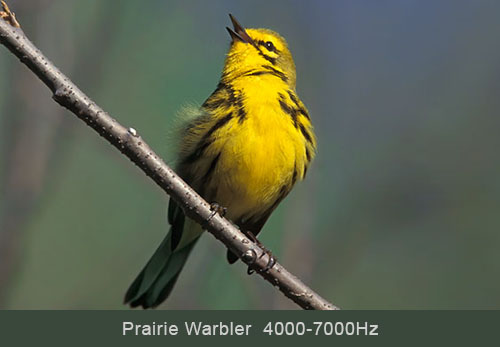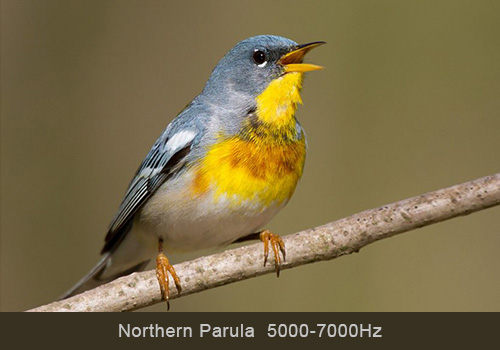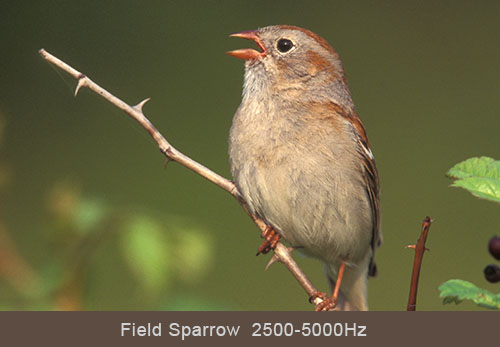The Problem – High Frequency Hearing Loss
As we grow older, we experience diminished sensitivity to high frequency sounds. Youthful hearing extends as high as 20,000 Hz (Hz = cycles/second). However, the average person over fifty or sixty years of age (especially among men) has completely lost the very highest frequencies and often suffers significant hearing loss in the range from 4,000 to 10,000 Hz. Moderate to severe hearing loss above 4,000-5,000 Hz becomes the norm for many individuals living sixty and beyond.
Loss of hearing with age, a condition technically referred to as “presbycusis,” is a widespread phenomenon that seemingly cannot be avoided. To make matters worse, prolonged exposure to loud music and other loud background sounds also results in reduced sensitivity in the high range (even among younger people). This is NOT good news for aging birdwatchers for the simple reason that most birds (especially songbirds) are difficult to spot and are generally discovered and identified by hearing their songs.

Diagram showing presbycusis – hearing loss due to aging
Another common form of high frequency hearing loss results from exposure to loud noises, either involving a single catastrophic event (eg. a nearby explosion) or else prolonged exposure to loud machinery, gunshots, music, and the like. This is referred to as “noise-induced hearing loss” (HIHL) and is typified by a moderate to extreme “notch loss” centered around 4000 Hz, with frequencies above and below less affected, depending on how much damage has occurred. Unfortunately, a huge number of birds sing in this range.

The average frequency of the songs of songbirds is around 3500 to 4000 Hz, approximately the same pitch as the highest note of a piano. Many warblers, sparrows, waxwings, kinglets, and a number of other birds produce sounds that reach 8,000 Hz and above. It follows that significant hearing loss in the 3000-8000 Hz range spells disaster for those interested in birding by ear, thereby making it nearly impossible to hear the songs of a great number of species in normal outdoor situations.

The situation with insects is even worse because vast majority of insect songs are at frequencies above 3,000-4,000 Hz, with some even reaching 20,000 Hz or higher. Thus, high frequency hearing loss will have a profound impact on one’s ability to hear singing crickets, katydids and cicadas. Even our ability to hear frogs and toads can be compromised. Spring Peepers chime in at around 3,000 Hz, Oaks Toads at 4500 Hz, and Little Grass Frogs at 7000 Hz.
While presbycusis may not have a strong impact on the lives of city dwellers and others who rarely venture into nature, high frequency hearing loss is disastrous for bird enthusiasts because it may prevent one from hearing the vast majority of the songs and calls of our native birds. This is especially painful for older people who are new to birding … many quickly discover that they cannot hear what “most everyone else is raving about” and are thus unable to share in the excitement.
With all the technological advances of this modern world, one would think there are a number of elegant solutions, but it turns out there are far fewer than one might expect …

The Amplification Solution
 The traditional approach to counteracting hearing loss has been to utilize amplifying hearing aids that raise the amplitude of incoming signals to levels where they can be heard. In modern times, this is done with electronic hearing aids that work well in the realm of speech perception (mostly below 3,000 Hz) but have limited application for birders and other nature lovers who can hear speech reasonably well, yet are deaf to high-pitched bird songs. For aging birders, conventional amplifying-type hearing aids are usually a major disappointment. Some of the problems encountered with such devices are summarized as follows:
The traditional approach to counteracting hearing loss has been to utilize amplifying hearing aids that raise the amplitude of incoming signals to levels where they can be heard. In modern times, this is done with electronic hearing aids that work well in the realm of speech perception (mostly below 3,000 Hz) but have limited application for birders and other nature lovers who can hear speech reasonably well, yet are deaf to high-pitched bird songs. For aging birders, conventional amplifying-type hearing aids are usually a major disappointment. Some of the problems encountered with such devices are summarized as follows:
1) There is a limit to how much a hearing aid can amplify before feedback squeal occurs. If hearing loss is severe, maximum amplification will not be adequate to allow high bird songs to be heard at reasonable distances in typical outdoor situations.
2) Conventional aids generally do not produce good amplification above 5,000 Hz. Thus, most amplifying hearing aids offer little or no help with hearing the highest singing birds.
3) Extraneous sounds such as wind noise or the sounds that accompany walking through leaves or stepping on twigs are also amplified and can be extremely annoying. Users often complain of “sensory overload” due to the continuous high-level amplification of such environmental sounds.
4) Even when users wear amplifying aids in both ears, the ability to determine distances and directions of incoming sounds is normally much reduced. The three dimensional or binaural aspect of hearing is greatly compromised and it becomes difficult, if not impossible, to find birds, even when they are heard.
5) The ability to enjoy the “softness” of distant bird songs is entirely lost. When extreme amplification is applied, softer sounds are boosted to high levels in order to be detected. And when they are detected, they are perceived as being “very loud,” even though they’re not. This can easily overwhelm and disorient the senses.
6) Amplifying-type aids generally “plug the ears” in order to create a tight seal to reduce the possibility of feedback squeal. This not only feels uncomfortable but also prevents users with intact hearing in the lower ranges from enjoying the wide and spacious immersion of their extant natural hearing.

In spite of the problems described above, conventional amplification-type aids can certainly be helpful to those with mild to moderate high frequency hearing loss, especially when models are used that specifically advertise exceptional high frequency response. But such hearings aids are generally quite expensive. For instance, it is not uncommon for a person to pay several thousand dollars each, with a total expenditure of well over $5000 for professional fitting in both ears. And there is no guarantee that the aids will end up being that useful in actual outdoor situations where the ability to hear and locate soft and distant sounds is all-important for a fruitful birding experience.
Note: If you’ve been reading the news, you may be aware that we are on the cusp of an explosion of affordable “Personal Sound Amplification Products (PSAPs)” that lie outside the highly-regulated domain of conventional hearing aids. These may help, for sure, especially when one’s hearing loss is moderate, but will probably not be able to adequately address the specialized requirements of birders and other nature lovers with loss in the higher frequencies. Nonetheless, it is a good idea to keep abreast of developments along these lines.
Who knows … some large company may develop an assistive listening device made specifically for the birding audience and throw tons of money toward finding the best solution, perhaps even integrating our pitch-lowering approach, which is described in below.

Our Pitch-Lowering Solution – Effective and Inexpensive
Given that potential users have moderate to severe hearing loss above around 3000Hz yet still have fairly good hearing in the lower range, up to around 2000-2500Hz or thereabouts (which is often the case for high frequency hearing loss due to both presbycutis and exposure to loud noises), a totally different approach to bringing back the high singers can be employed … and that is to pitch-shift high bird songs into the lower range where they can heard without the need for amplification.
As you might guess, this is exactly what our Hear Birds Again app will do, giving the user fine-grained control over what frequencies are shifted and the degree of pitch-lowering that is applied. Furthermore, by using our app in conjunction with a loose-fitting “open-air binaural headset,” the lowered bird songs can be seamlessly added to the soundscape the user is already hearing, without impairing the user’s still-useful hearing range. There will be no plugging of the ears (as occurs with amplification aids) and the resulting mix will sound so real that the user will have difficulty distinguishing a shifted bird song from one that is being heard naturally.
With the above in mind, it should be apparent that our project not only involves the creation of the pitch-shifting app itself, but also an optimal binaural headset design, so that one’s actual outdoor listening experience is as natural as possible. A detailed discussion of this matter can be found below in the section labeled The Headset Conundrum.

You may wonder how Hear Birds Again will accomplish the frequency shifting. Briefly, incoming bird sounds will be received by tiny mics positioned on the headset at each ear, and then routed into the mobile device, where they will be converted into digital signals. Our app will then selectively pitch-lower the high-range songs using advanced algorithms tailored specifically for this purpose. Finally, the pitch-lowered songs will be fed back to each ear via the headset, where they are then “mixed” with the natural soundscape one is already hearing.
There are a number of approaches to frequency division and several well-known algorithms are currently available for our use. While we have already developed our own basic algorithm based on a fairly simple “sample-and-stretch” model that allows for several pitch-shift settings (one-half, one-third and one-quarter), we also intend to implement a more advanced solution that will provide considerably more control over the amount of shifting.
Note that most available algorithms have been developed for shifting human speech and music. Bird songs, especially those containing numerous “rapid transients,” pose specific challenges and it turns out that some of the leaner algorithms actually produce the best results. Although we plan to implement just one or two algorithms when we launch our app, we will be continually testing new ones as they appear and then adding those that work best with bird songs.

IN CONCLUSION, our pitch-lowering solution, the Hear Birds Again mobile application used in conjunction with a special binaural headset (described below in The Headset Conundrum, will allow for the preservation of a natural, three-dimensional “binaural” listening experience where the pitch-lowered songs will be transparently mixed with sounds one is already hearing. The lowered bird songs will be heard at normal or near-normal levels and users will be able to determine their directions and distances, making it possible to actually find and observe the singers.
Given that pitch-lowering does not involve extreme amplification, extraneous sounds like the rustle of leaves or the snapping of twigs will not be annoying. There will be no uncomfortable plugging of the ears. Furthermore, sensory overload will be completely avoided, feedback squeal will not occur, and the overall effect will be gentle, natural and spacious. For bird enthusiasts who suffer from moderate to severe high frequency hearing loss but who still have fairly normal hearing up to around 2000Hz, Hear Birds Again used in conjunction with a well-designed binaural headset will provide an excellent solution to the problem of bringing back the high singing birds.
A Note About Pitch-lowering in Amplification-type Hearing Aids: There are a number of advanced (and often very expensive) amplification-type hearing aids that utilize some form of pitch-shifting to help with speech discrimination. Sometimes they even advertise improved ability to hear bird and other nature sounds. Unfortunately, most of these algorithms are designed specifically for improved human speech recognition and do not work well with bird songs.
In some cases, only a narrow high-frequency band is shifted downward, which means that the songs of many species will be missed. Other algorithms may aggressively “compress” the high frequencies into a narrow, lower frequency band, thereby flattening or squashing the bird songs and degrading harmonic relationships. Still other so-called “adaptive” algorithms may only respond to the high-pitched portions of speech (such as “ssss” or “shhhh”) while actively rejecting other types of sounds, including many bird songs or calls.
So … one should not expect great results just because an expensive amplification-type hearing aid includes pitch-lowering features. But this doesn’t mean that all expensive aids will be inadequate in this respect. As part of this project, we will be testing conventional aids whenever possible, in hopes that we can determine which brands utilize pitch-shifting algorithms that work well with bird songs and allow for most of the high-pitched singers to be heard.

Will “Hear Birds Again” Help You?
Hear Birds Again will be targeted at those who suffer from moderate to severe high frequency hearing loss in the higher ranges, but who still have fairly good hearing up to around 2,000-2,500 Hz in both ears. Such individuals may be almost completely deaf to high-pitched bird songs but will be able to hear human speech and low singing birds such as whip-poor-wills, robins, and cardinals, without the need for special hearing aid devices.
Note that while our app will primarily be a pitch-lowering device, it will also offer a reasonable degree of amplification of the pitch-lowered signals, which will be helpful to those are have some loss at the low end.

We strongly advise potential users to obtain an audiogram from an audiologist, who should be instructed to pay particular attention to high frequency response, preferably measuring up to 8000Hz. Look for moderate to severe hearing loss above 3,000-4,000 Hz with normal or near-normal hearing up to around 2,000 Hz. You might also try testing yourself using the exceptional online hearing test kindly provided by the University of New South Wales.
If there is moderate loss at around 2,000 Hz, the utility of our app will be somewhat reduced, but note that users can easily boost the volume of pitch-lowered bird songs to compensate. In addition, it will usually possible to use our recommended binaural headset in conjunction with conventional hearing aids, although feedback squeal may be a significant issue.

We will be experimenting with ways to make Hear Birds Again more usable by people with moderate loss in the lower range, possibly by allowing for amplified “pass-through” of the low end without any pitch-shifting. However, due to potential feedback problems, a specially-designed headset would be required that fits tightly over both ears. Please refer to section below to gain a greater understanding of the challenges involved with regard to headset design and functionality.
The Headset Conundrum
While our Hear Birds Again application can be roughly-tested using the mobile device’s internal microphones in conjunction with earbuds, users will not experience the pitch-lowered bird songs in a natural three-dimensional space and will not be able to accurately judge their distances and directions. In order for high-pitched singers to both be heard and located in the environment, our app must be used in conjunction with a well-designed “binaural headset” that has mics mounted at each ear, thereby simulating our natural hearing where our two ears are spaced about seven inches apart, with an absorbent barrier (= the head) lying in between.

The reason this is important is that our brains are hard-wired to decipher audio signals produced by this arrangement, which preserves critical binaural directional cues such as “inter-aural time differences” and “inter-aural level differences” of sounds arriving at the two ears. Think about it … a bird song originating from the right will arrive at the right ear before it arrives at the left ear, the delay being a function of the speed of sound. Furthermore, the bird song will be louder in the right ear and more subdued in the left ear, due to the blockage or absorbance of the head.
So, if a binaural headset is used, the directional cues will be preserved as the left and right input signals are processed and then fed back to the listener via the corresponding receivers in the headset. The brain then processes the pitch-lowered sounds automatically, and literally “projects” them into a natural three-dimensional space that sounds so real and spacious that listeners may not realize that a detected bird song has been lowered in pitch.
Quite obviously, use of a binaural headset is critical to having the highest quality experience, but there’s a problem here: Currently, there are no off-the-shelf commercial binaural headsets available in the marketplace, and certainly none that meet two necessary criteria:
1) The headset must include two “super low-noise” input mics, securely mounted next to each ear (mics with low self-noise are especially important for detecting soft and distant bird songs in natural environments).
2) The headset must employ a loose-fitting open-air design that does not plug the ears, so that lower-pitched sounds (in the range where one’s hearing is still normal or near-normal) are heard naturally, just as they are when the headset is not worn.

Now you may understand why the title of this section is “The Headset Conundrum.” Use of a binaural headset is all-important, yet none are currently available in the marketplace. So what are we to do? Well, at least for the time-being, there is only one obvious solution, and that is to to build optimal headsets using readily-available materials. And that is the approach we’re taking.
In fact … we have already prototyped a headset design that works great in the field and that will lend itself well to a do-it-yourself (DIY) approach. We have also partnered with micbooster.com, a firm in the UK that makes miniature low-noise microphone modules optimized for recording natural sounds. Micbooster is now providing “headset kits” that include pre-wired mics, earphones, and all other materials needed for the final construction … which will require very little effort from buyers.
In addition, for those who are adept at soldering miniature components, we provide a detailed list of components (which can be ordered separately), along with assembly instructions. If demand for headsets turns out to be great enough, it is quite likely that one or more enterprising individuals will decide to build and sell fully-assembled headsets.
Below is a photo of our current prototype headset, a relatively straightforward design that works splendidly in the field. Go Here for information about ordering headset kits from micbooster.com, or else Go Here for information about buying components individually to build your own headset.
Miscellaneous Headset Considerations
A Note About Bluetooth
You may wonder why our headset is “wired” to the iPhone, when wireless bluetooth has become so ubiquitous. The answer is a bit complicated.
First off, it is currently quite difficult to enable “two way communication” where a two-channel input (from the headset mics) is processed by the mobile app and then fed back to the headphones without any delay. Bluetooth has latency (delay) issues in both directions, which means that the pitch-shifted output sent back to the headphones will be slightly delayed in comparison to the actual sounds occurring in nature. In a completely closed system, this might make little difference (although it would be obvious if one is actually watching a bird sing and the movements of the beak precede the pitch-lowered song phrases being heard). When using an open-air approach, however, the problem will be compounded with bird songs that have both high and low elements (such as robin songs). In such cases, the high portions of songs will be pitch-shifted and therefore delayed, while the lower elements will be heard in real time, with no delay, Thus, mixing the two together would cause a noticeable degradation of the internal timing of the song.
Yet another significant problem with the bluetooth approach is that adding two bluetooth transmitters and receivers to the headset would significantly increase its bulk and weight, making it more difficult to use. So, at least for now, there is no reasonable way to make a compact bluetooth headset that will produce optimal results. While our straightforward wired solution may seem a bit archaic, it is eminently workable in the here and now, and there are no annoying delays in the routing of sounds into and out of the mobile device.
We definitely look forward to the day when a fully-wireless headset can be implemented. In the best-case scenario, some large manufacturer of assistive listening devices will build and sell “the perfect binaural headset,” input mics included, with an integrated bird-song-optimized pitch-lowering algorithm built into the electronics inside the headset (which means there would be no latency issues). Wishful thinking? Perhaps, but why not hope for the best?
An Altogether Different Approach to Headset Design
The headset design that we described above assumes reasonably good hearing up to around 2000Hz. It utilizes an “open-air” design where the receivers sit lightly on each ear and do not obstruct one’s intact hearing. This approach works great for those who still have useful hearing in the mid-range, but it does not adequately address those who have substantial loss below 2000Hz.
An entirely different approach is to use closed-back headphones with foam ear cups that provide maximum isolation and rejection of outside sounds … in other words, a closed system. Such headphones may also employ active noise-cancellation circuitry to attain even greater isolation (eg. the Bose QuietComfort). Mics can be mounted on the outside of such headphones, with wires leading into the iPhone. Our app could then do the pitch-lowering and also provide an amplified “pass-through” of the lower range, to compensate for hearing loss in that range. A tight seal is required because pass-through amplification can easily cause feedback squeal, if the mics are able to “hear” the signal coming out of the headset receivers.
With this approach, the user will only hear what is coming through the headset and no aspect of the soundscape would be heard directly. Obviously, such a closed system would give full control over both the loudness of the lowered high-pitched bird songs as well as the loudness of the lower un-processed “pass-through” signals. Thus a binaural sound-field would be experienced entirely through the headset itself.
This approach is certainly viable, but there are caveats. One big concern is that feedback squeal will cause problems if there is too much amplification of the pass-through signals. Another concern is that the microphones mounted on the outside of the headset will be extremely sensitive to wind, which means that the slightest breeze may easily cause low frequency distortions (a problem largely eliminated by the “high-pass” filtering of mic input signals that occurs with our open-air approach).
In spite of the problems associated with a closed-system approach, we plan to experiment with various headset designs (coupled with modifications of our app) to see if we can come up with a workable do-it-yourself solution for nature enthusiasts with mild to moderate hearing loss at frequencies below 2000Hz.